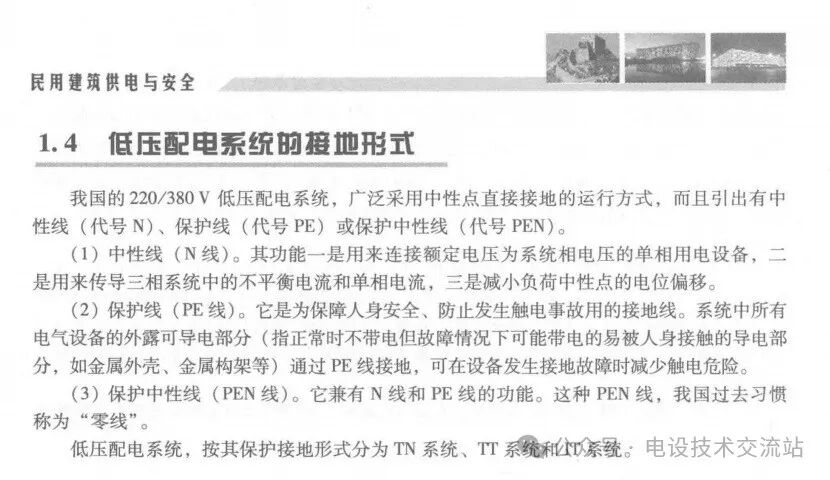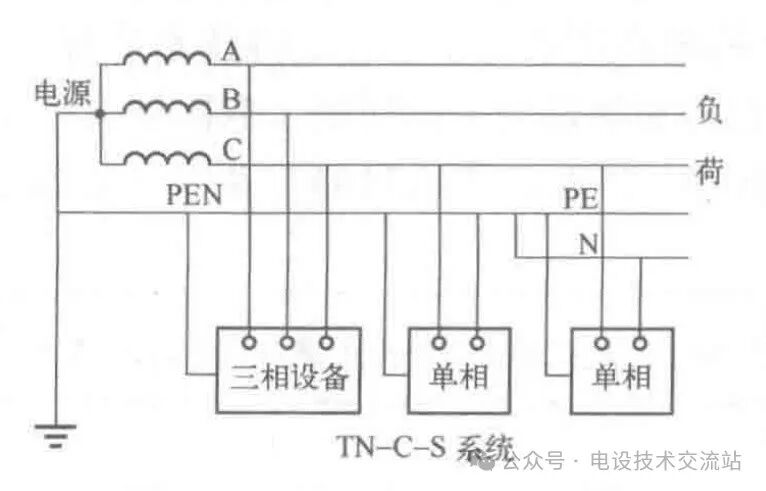For more exciting content, please click the blue text above to follow me!
In the book “Power Supply and Safety in Civil Buildings,” three grounding methods for low voltage distribution systems are defined, named as follows:
1) TN System;
2) IT System;
3) TT System;
Below, I will share detailed information about each grounding system.

From this textbook, can you see the labels:N, PE, PEN, what do these three labels mean??
In the TN system, based on the relationship between the protective neutral wire (PE) and the working neutral wire (N), it is further divided into three cases, named TN-S system, TN-C system, and TN-C-S system.
TN-S System:

It is important to note the details of the connection between N and PE for three-phase and single-phase electrical equipment in the TN-S system.
As shown in the figure, for three-phase equipment, the working power supply consists of Ua, Ub, and Uc three phases;
For three-phase four-wire connected equipment, the working power supply consists of Ua, Ub, Uc, and Un four wires;
For single-phase powered equipment, the working power supply is formed by selecting one phase from Ua, Ub, Uc and combining it with Un;
The PE mentioned above is the protective neutral wire, which connects to the equipment casing, and it must ensure that the equipment casing is not live.
If the equipment casing becomes live due to operation or other reasons, it must be discharged through PE to ensure safety..
The main feature of the TN-S system is that the N wire and PE wire are completely separated at the system neutral point. All electrical equipment connected to this system must ensure this wiring and operating method; if the wiring does not comply with this specification, it will undermine the advantages of this system, and the TN-S system will no longer be valid..
The characteristics of this system are as follows:
1) When the system is operating normally, there is unbalanced current on the working neutral wire (N), and there is no current on the protective neutral wire (PE), so the PE wire has absolutely no voltage to ground, and the metal casing of electrical equipment connected to the protective neutral wire PE is safe and reliable.
2) The working neutral wire (N) is only used to provide power for single-phase electrical equipment, such as lighting, televisions, etc.
3) The protective neutral wire (PE) must not be disconnected, nor can it be interrupted, and it must not enter a leakage protection switch.
4) Electrical equipment in the same power system must not be partially grounded or partially connected to neutral. Otherwise, when the protective grounding equipment experiences leakage, it will cause the neutral point grounding line potential to rise, resulting in the metal casing of all equipment using protective neutral becoming live.
5) The cross-section of the protective neutral wire (PE) should not be less than that of the working neutral wire, and it should be distinguished from other wires using yellow/green two-color wire, with a cross-section of no less than 2.5mm2 of insulated multi-strand copper wire.
TN-C System:On the basis of the above TN-S system, the protective neutral wire (PE) and the working neutral wire (N) are combined into one wire to save one wire, forming a new system, officially named the TN-C system, as shown in the figure below:
Everyone should pay attention, in the wiring of three-phase electrical equipment, whether it is three-phase three-wire or three-phase four-wire equipment, the wiring method is the same; for single-phase powered equipment, one phase is still selected from A, B, C phase to supply power with PEN..
The characteristics of this TN-C system are as follows:
1) If the equipment casing becomes live, the PEN line can raise the leakage current to short-circuit current, which is essentially a single-phase to ground short-circuit fault. The fuse will quickly blow or the circuit breaker will trip, ensuring the safety of the system’s power supply.
2) It is only suitable for situations where the three-phase load is basically balanced; otherwise, it will lead to unbalanced current on the PEN, which will cause voltage on the PEN to ground, ultimately resulting in a certain voltage on the metal casing of electrical equipment connected to PEN, creating safety hazards.
3) If the PEN line is disconnected, the equipment casing will become live, leading to safety hazards.
4) If the phase line of the power supply is grounded, the potential of the equipment casing will rise, spreading the dangerous potential on the neutral line.
5) The neutral line through the leakage protection switch can only be used as a working neutral line and cannot be used as a protective neutral line for electrical equipment, which is determined by the working principle of the leakage protection switch.
TN-C-S System:If the TN-S system and TN-C system are not properly managed during use, the following figure is formed:
In the entire TN-C-S system, PEN replaces the working neutral wire and protective neutral wire, and is separated at a certain point as needed, thus forming the wiring method shown in the figure, which is also known in the industry as the “local three-phase five-wire system”,
The first part is the TN-C system,
The second part is the TN-S system, with the boundary at the connection point of the N wire and PE wire.
The characteristics of this TN-C-S system are:1) The PEN line must never enter the leakage protection device under any circumstances, as the action of the leakage protection device at the end of the line will cause the previous leakage protection device to trip, resulting in widespread power outages.
2) For the PE line, except for the connection with the N line at the main box, the N line and PE line must not be connected at other sub-boxes, and no switches or fuses are allowed to be installed on the PE line.
3) It can reduce the voltage of the motor casing to ground, but it cannot completely eliminate this voltage. The magnitude of this voltage depends on the load imbalance and the length of the line.
——– River Master Wishes —————
Man Jiang Hong • Power Heroic Journey
Twenty years of journey, braving frost and snow, studying electricity without pause.
With a loyal heart, bravely driving through thorns, skill sharp as a blade.
Great masters sketching blueprints, waving flags at numerous construction sites.
See the iron army, advancing with battle flags raised, passionate and shining.
Pouring all I have learned, pouring it out.
Praying for likes, rejoicing together.
Hoping friends spread widely, enthusiasm cannot be bound.
Every bit of true knowledge becomes a blade, every thread of wisdom is like an arrow.
Waiting for tomorrow, the fire shines in the long sky, expanding the universe.
——————————
Creation is not easy, thank you for your attention, thank you for your likes, thank you for sharing!
Previous classic articles:
1) Human-Machine Interaction MMI Design Upgrade, Using Touch Screen Technology is the Future Mainstream Direction..
2) Do you know why it is necessary to develop reentrant functions in embedded uCOS-II?
3) The application of “Message Mailbox” in the embedded real-time operating system uCOS-II, I will explain it to you in detail..
4) What kind of logic is reasonable for residential distribution boxes? 95% of people absolutely do not know, I will share in detail..
5) Pointers to pointers, a programming skill that 80% of engineers do not use. Once learned and applied flexibly, every program written using it will become a classic case..
Since you are here, please give a thumbs up before you leave.~~~